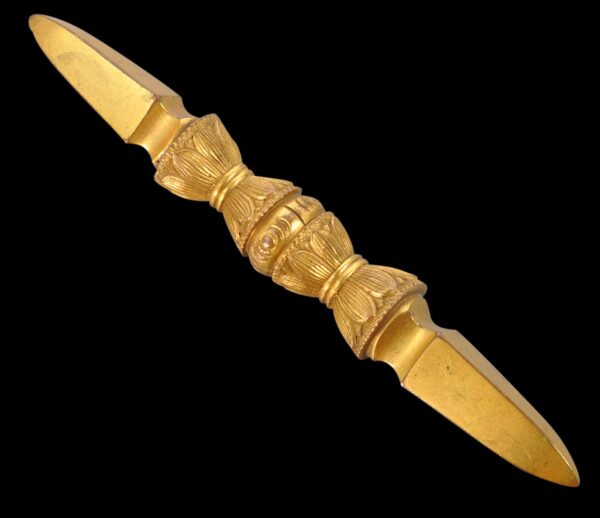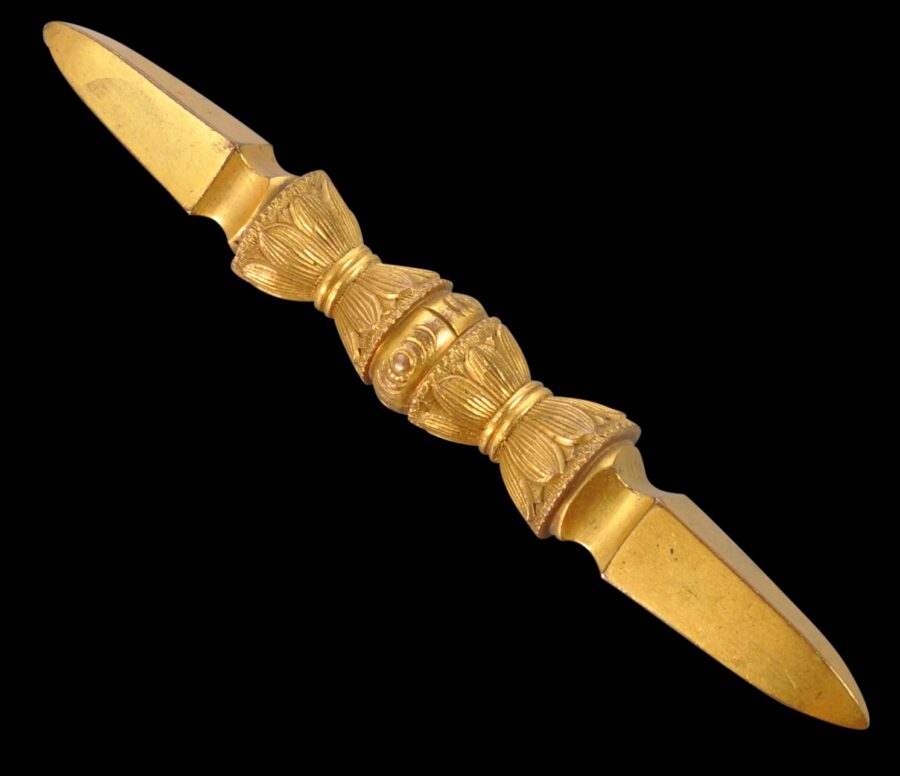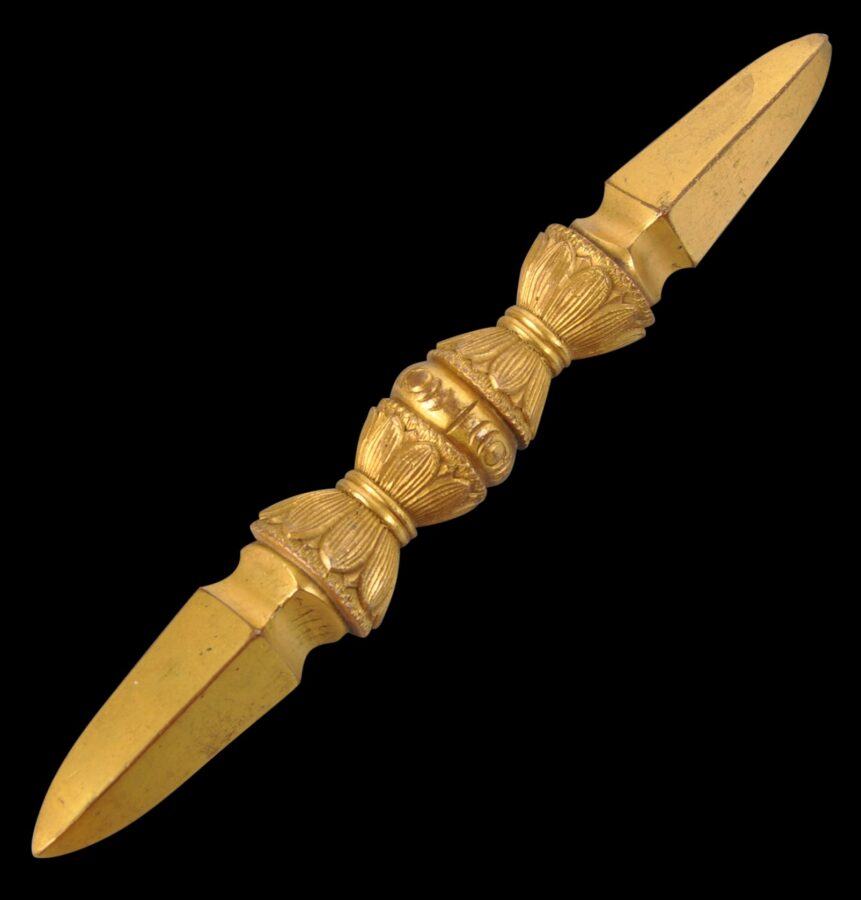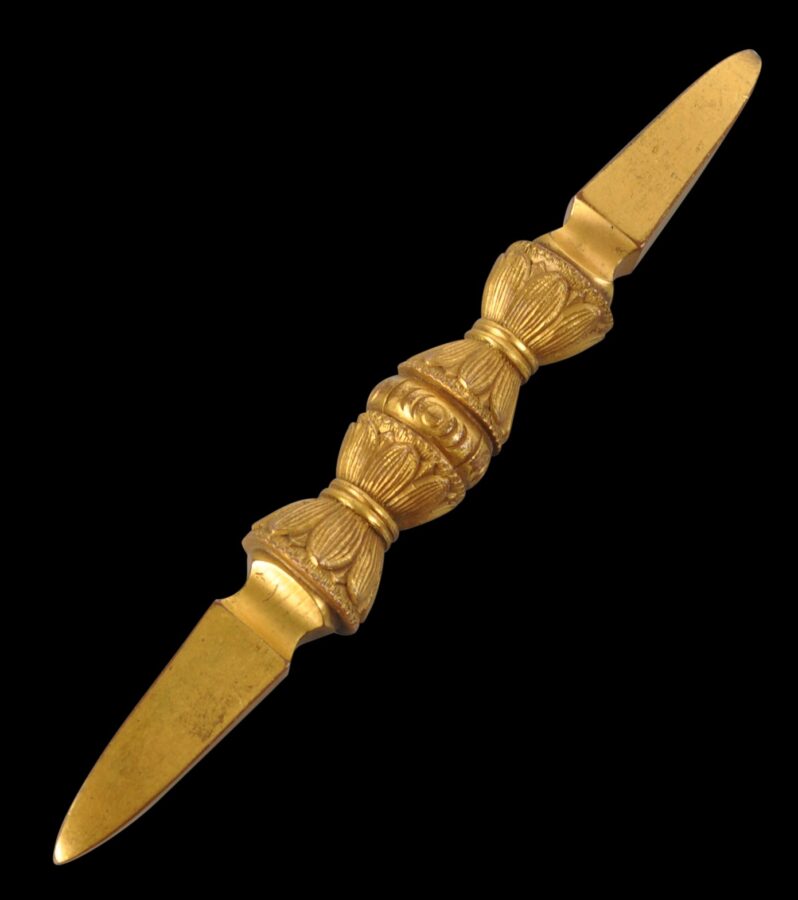Enquiry about object: 8981
Japanese Shingon Sect Gomadan Altar Gilded Copper ‘Pestle’ Vajra (Tokkosho)
Japan Edo Period, 18th-19th century
length: 14.7cm weight: 161g
Provenance
private collection, UK
This fine, single-pronged vajra or dorje is from 18th-19th century Japan. It was used by a priest of the Shingon sect in the Tantric fire goma ritual. Japanese vajras are seldom seen; more typically examples that come onto the market are from Tibet.
The example here is of gilded brass. It is beautifully cast and chiselled with elegant prongs, and a mid-section for the finger and thumb bordered by two pairs of double lotuses.
It is a fine sculptural work in its own right. Additionally, the ageing of the gilding has given the vajra a superb, soft colour.
The vajra is a short sceptre that has become one of esoteric Buddhism’s most important ritual implements. Based on the thunderbolt that the Hindu god Indra wielded to destructive effect according to legend. The Buddha took Indra’s weapon and bent the prongs inwards transforming the vajra into an instrument of peace. The term vajra or ‘diamond’ alludes to hardness and clarity. In Shingon Buddhism, the vajra suggests indestructible truth and wisdom that cuts through obstacles.
See related examples in Japan’s Nara National Museum, the Museum of Fine Arts Boston, and another in the British Museum. A related, single-pronged example attributed to the Muromachi Period (1336-1573) is illustrated in Bruijn (2011, p. 120).
The Shingon tradition has its origins in Buddhist Tantra in India between the second and sixth centuries. From India it was transmitted to China, and in the ninth century it was transmitted to Japan. The form that Shingon took as it arrived in Japan has barely changed to this day. The history of goma (goma-dan) ritual fire sacrifices however has much earlier origins – they were based on Vedic fire rituals. These were incorporated into Buddhist Tantra in India and thereafter were incorporated into what became Shingon practice.
The Shingon tradition has the third largest number of adherents among the various Japanese Buddhist sects. Many other sects have been deeply influenced by Shingon tenets and practice. It was introduced to Japan from Tang China in the ninth century. At that time, there was much religious exchange between China and Japan – Japanese monks would travel to China for instruction, for example. One of the appealing characteristics of Shingon compared with existing Buddhist sects in Japan at the time, was that Shingon ritual was more dramatic and visually interesting. Shingon was also assimilated with the existing indigenous religion of Shinto. This also helped Shingon to be more widely adopted.
Shingon, together with the Tantric component of Tendai (another important strand of Japanese Buddhism), forms the Japanese version of Tantric Buddhism. Goma is considered by adherents to be the highest expression of ritual practice in the Shingon tradition of Japanese Tantric Buddhism – the training (Shido Kegyo) of a Shingon Buddhist priest culminates with the goma, for example. The goma ritual became associated with the worship of the Five Great Kings of Light (Go Dai Myoo). Japanese aristocrats would sponsor the performance of such rituals in the hope that their daughters might produce male heirs, for example. The Imperial family subscribed to Shingon too at least initially, and buildings for Shingon practice were constructed within the grounds of the Imperial Palace.
The goma ritual takes place indoors at a permanent altar made for the purpose and made of fired bricks, along with several side altars. The altars have all manner of items associated with starting and maintaining a fire as well as items to be offered to the flames – incense, mustard seeds, medicinal herbs, sacred woods, and so on. In addition, there are various vajra – a single pronged vajra, a three-pronged vajra and a five-pronged vajra. During the goma ritual, these and other ritual items are moved to a side table, but the three-pronged vajra remains on the main altar. The rituals are primarily concerned with expelling demons and appeasing benevolent spirits. This is the context with which the ritual item here can be seen.
The vajra is in excellent condition. It has obvious age, a wonderful presence, with comparables being included among some of the world’s most important museum collections.
References
Bruijn, E., Tibet-China & Japan, Wereldmuseum, 2011.
Payne, R.K., The Tantric Ritual of Japan – Feeding the Gods: The Shingon Fire Ritual, International Academy of Indian Culture and Aditaya Prakashan, 1991.








